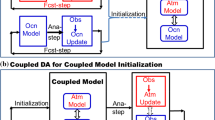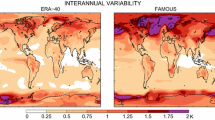The aim of coupled models is to represent the trajectory of the climate system as realistically as possible. Given the chaotic nature of the climate system, it is essential that the starting point of the coupled model trajectories (i.e. the initial conditions) is as close as possible to the observed climate trajectory. In order to ensure that this condition is satisfied, observations are used to modify the coupled model via the data assimilation approach. In the context of seasonal forecasting, data assimilation is nothing more than a combination of observations and model data, performed with the aim of achieving the ‘best’ initial state of the coupled model. However, what constitutes the best initial state is still under debate as it is not obvious whether the best seasonal forecasts are obtained by targeting (a) the most accurate initial state estimate or (b) the most consistent (with the model’s own preferred state) coupled state or (c) the coupled state that controls some particular growing modes, or indeed a combination of the three. In this chapter we will present generic data assimilation strategies, including some of their history, which could be adapted to any of these three options. If observations were abundant, one could just use the information given by the observations to obtain the best initial conditions. With the advent of satellites, the last 2 decades of the 20th century have seen an enormous increase in Earth observations. Despite this abundance of observations, large parts of the Earth system still remain unobserved: the interior of the ocean for instance can not be measured remotely. Data assimilation becomes therefore indispensable. At present, data assimilation is applied separately to the individual components of the coupled model. Ideally, the initialisation should be realized using the coupled model directly but this approach, as discussed in this chapter, is still in its infancy and progress is not expected to be fast as many obstacles, not least the presence of serious model errors in both atmospheric and oceanic models, still hinder its way to a full mature phase.
Access this chapter
Tax calculation will be finalised at checkout
Purchases are for personal use only
Preview
Unable to display preview. Download preview PDF.
Similar content being viewed by others
Author information
Authors and Affiliations
Editor information
Editors and Affiliations
Rights and permissions
Copyright information
© 2008 Springer Science + Business Media B.V
About this paper
Cite this paper
Tribbia, J., Troccoli, A. (2008). Getting the Coupled Model Ready at the Starting Blocks. In: Troccoli, A., Harrison, M., Anderson, D.L.T., Mason, S.J. (eds) Seasonal Climate: Forecasting and Managing Risk. NATO Science Series, vol 82. Springer, Dordrecht. https://doi.org/10.1007/978-1-4020-6992-5_5
Download citation
DOI: https://doi.org/10.1007/978-1-4020-6992-5_5
Publisher Name: Springer, Dordrecht
Print ISBN: 978-1-4020-6990-1
Online ISBN: 978-1-4020-6992-5
eBook Packages: Earth and Environmental ScienceEarth and Environmental Science (R0)




